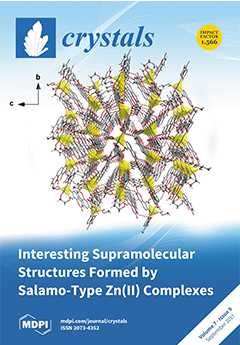The crystal structures of salts
6–
9 prepared from (
R)-2-methoxy-2-(1-naphthyl)propanoic acid [(
R)-MαNP acid, (
R)-
1] and (
R)-1-arylethylamines [salt
6, (
R)-1-(4-methoxyphenyl)ethylamine∙(
R)-
1; salt
7, (
R)-1-(4-fluorophenyl)ethylamine∙(
[...] Read more.
The crystal structures of salts
6–
9 prepared from (
R)-2-methoxy-2-(1-naphthyl)propanoic acid [(
R)-MαNP acid, (
R)-
1] and (
R)-1-arylethylamines [salt
6, (
R)-1-(4-methoxyphenyl)ethylamine∙(
R)-
1; salt
7, (
R)-1-(4-fluorophenyl)ethylamine∙(
R)-
1; salt
8, (
R)-1-(4-chlorophenyl)ethylamine∙(
R)-
1; and salt
9, (
R)-1-(3-chlorophenyl)ethylamine∙(
R)-
1] were elucidated by X-ray crystallography. The solid-state associations and conformations of the MαNP salts were defined using the concepts of supramolecular- and planar chirality, respectively, and the crystal structures of salts
6–
9 were interpreted as a three-step hierarchical assembly. The
para-substituents of the (
R)-1-arylethylammonium cations were found on sheet structures consisting of 2
1 columns. Thus, salts possessing smaller
para-substituents, that is, salt
7 (
p-F) and salt
9 (
p-H), and larger
para-substituents, that is, salt
6 (
p-OMe) and salt
8 (
p-Cl), crystallized in the space groups
P2
1 and
C2, respectively. Additionally, weak intermolecular interactions, that is, aromatic C–H···π, C–H···F, and C–H···O interactions, were examined in crystalline salts
6–
9.
Full article





